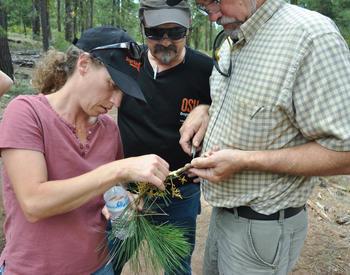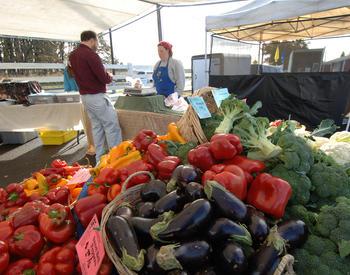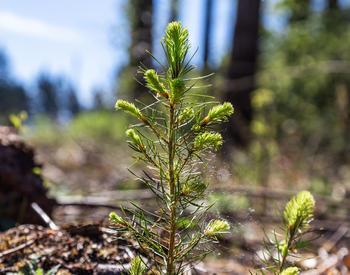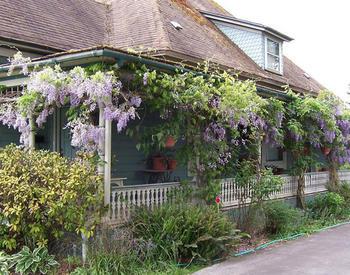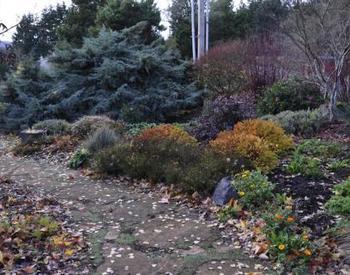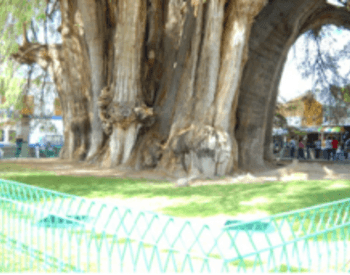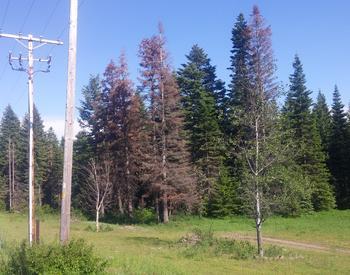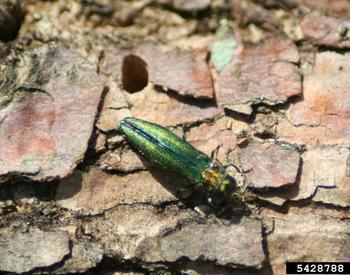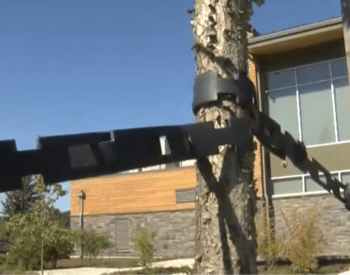OREGON CITY, Ore. – Oregon State University Extension Forester Glenn Ahrens and his team worked for months preparing for the 2020 Clackamas Tree School. They recruited presenters, exhibitors and sponsors, and promoted the bustling, one-day event to thousands of Oregon woodland owners.
It was a huge job. Ahrens, coordinator Amanda Brenner and registrar Jean Bremer started planning in August 2019. When registration opened in January for the March 21 event, the school and its 75 different classes filled up quickly. More than 650 participants signed up for classes, which ranged from safely operating chainsaws to managing understory vegetation. The event would fill the Clackamas Community College gymnasium and many surrounding classrooms.
Clackamas Tree School, celebrating its 30th year as the largest one-day education event for private woodland owners and professional foresters, promised to be bigger than ever.
Then the COVID-19 pandemic reared its ugly head.
“We were on the edge of our seats, wondering what was going to happen,” Ahrens said. “We kept asking authorities if it would be safe for us to hold the event.”
Finally, on March 10, with a big catering deadline looming, the team was forced to postpone. Two days later, state officials instituted restrictions on large gatherings. Although the team had hoped to reschedule Tree School for the fall, the community college was unable to find a date when all the facilities required would be available.
For a second time, they were forced to think: “What now?”
Once again, the team pivoted. Ahrens and his crew started planning to put the school online. The various field classes would have to be scrapped, but many sessions could be adapted for online.
At the same time, Mike Cloughesy, director of forestry for the Oregon Forest Resources Institute (OFRI), was making plans for developing webinars for forest landowners. Working together, they quickly developed plans to produce Tree School Online as a collaborative effort with the Oregon Partnership for Forestry Education. Most of the partners were already involved with Tree School, so it was a natural fit to team up on the webinars. Grants from the U.S. Forest Service and the Oregon Department of Forestry (ODF) helped fund the effort.
“We’d all been using Zoom a lot in our jobs at that point, so we decided to turn Tree School into a series of webinars,” Ahrens said.
It wasn’t as easy as it sounds. At the same time the Tree School team was cancelling the physical event and coordinating refunds, they were also promoting the free online program, which would be spread out over several weeks with one or two presentations offered live each Tuesday morning and afternoon.
Organizers began surveying presenters to determine who would be willing to teach online, and dozens stepped forward. Hundreds of Oregon’s small woodland owners signed up for the online sessions. On April 21, just a month after the date for the in-person event, the first Tree School Online session debuted with 300 registered participants. Since then, the live classes have rolled out with anywhere from 50 to 100 participants. Many more watch the recorded version of the presentations at other times.
Tree School Online has been an ongoing learning experience for both students and presenters. Even veteran instructors like Ahrens and other Extension forestry and natural resources faculty have learned how to make engaging in-person presentations just as effective to a remote audience. The Clackamas event was one of five regional tree schools affected by COVID-19.
“Classroom lectures don’t naturally translate to a webinar format, so we’re all learning how to be better at that,” Ahrens said. “For instance, I’ve learned to keep the pictures in my presentation moving faster. If you leave them up on the screen too long, people might get bored.”
Presenters have also become adept at using online tools to engage their audiences. They poll their classes to discern their feelings about such topics as climate change and wildfire danger, and students can see the results in real-time. Instructors also collect feedback on their presentations and compare notes on techniques that work best to keep their audience interested.
Instructors also take advantage of online question-and-answer features. While some students might be too bashful to ask a question in person, they happily post questions online. The instructors welcome these queries and many go past their scheduled class-time to answer them. Most get up to 30 questions per class – far more engagement than they’d get in a live setting, Ahrens said.
Some elements of Tree School aren’t the same, of course. One is the exhibit hall. Most tree schools have around 70 exhibitors, but the organizers haven’t been able to replicate that experience online.
“We’re working on it, though,” Ahrens said. “We’re talking to sponsors about a virtual exhibit hall for future sessions, but many exhibitors are scrambling to deal with their own COVID-related business issues.”
The original Tree School Online webinars continue through July 28 and will resume with a new slate of bimonthly online classes on Sept. 15. The details will be forthcoming, but Ahrens said he and his Extension team and their collaborators will spend August reviewing feedback from participants and developing best-practice tips to help presenters.
While shifting an established and popular live event to a weekly online series has been challenging, Ahrens said the “consolation prize” has been the extensive library of online educational materials Extension now has. The recorded presentations from Tree School Online can now be used as resource materials when Extension educators “flip” their classrooms. In a flipped classroom, students are directed to educational resources to review privately and then return to the classroom to discuss what they discovered.
“We’ve always wanted to do more of this, and the pandemic has given us the incentive to do more online education,” Ahrens said.
Although several Extension educators participate in Tree School, many others come from public agencies or private industry. OFRI’s Cloughesy hosts many of the presentations, and presentations have been made by experts from Ecotrust, the U.S. Forest Service, ODF, New World Truffieres, the Oregon Woodland Cooperative, Clackamas County and various soil and water conservation districts in western Oregon. Forests Forever Inc., the community college, and the Clackamas County Farm Forestry Association, help put on the school. The event also relies on volunteers like Rob Guttridge, who manages the Exhibit Hall.
In the 40-page conference class booklet, Ahrens, who is also the Extension forester for Hood River and Marion counties, gives special praise to Mike Bondi, the Extension forester and regional administrator who started the event in 1991 and is retiring this year.
“Mike has led the effort to develop Tree School into a great collaborative education event,” Ahrens said. “The school is a lasting legacy to his leadership.”
